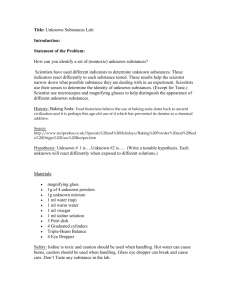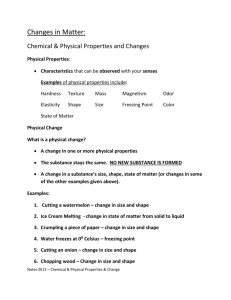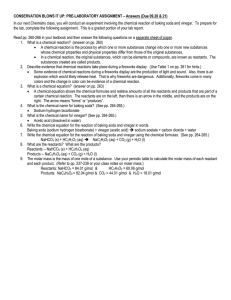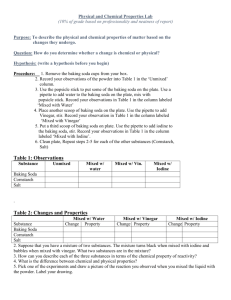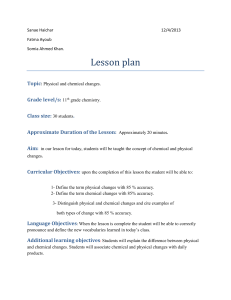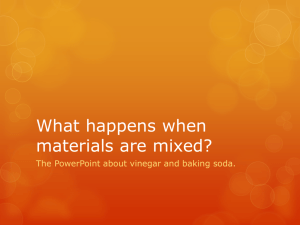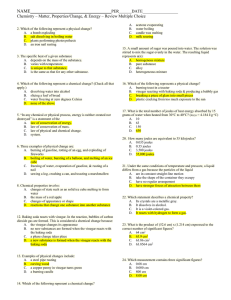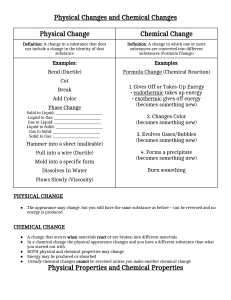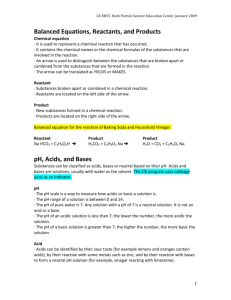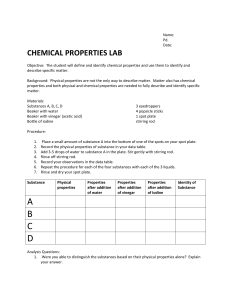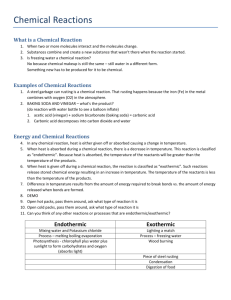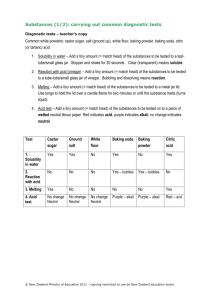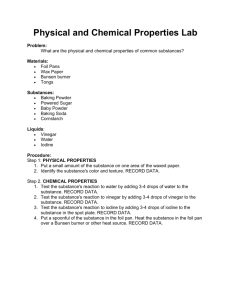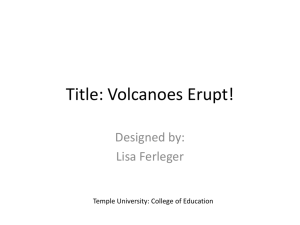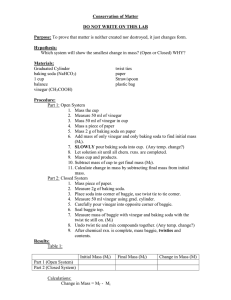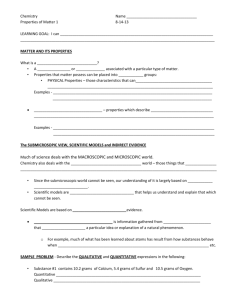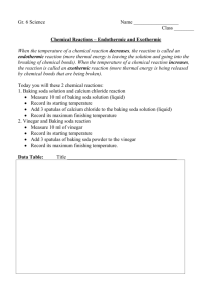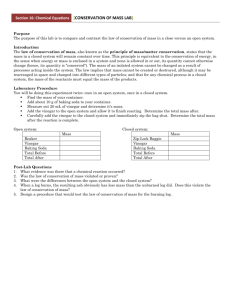Density
advertisement
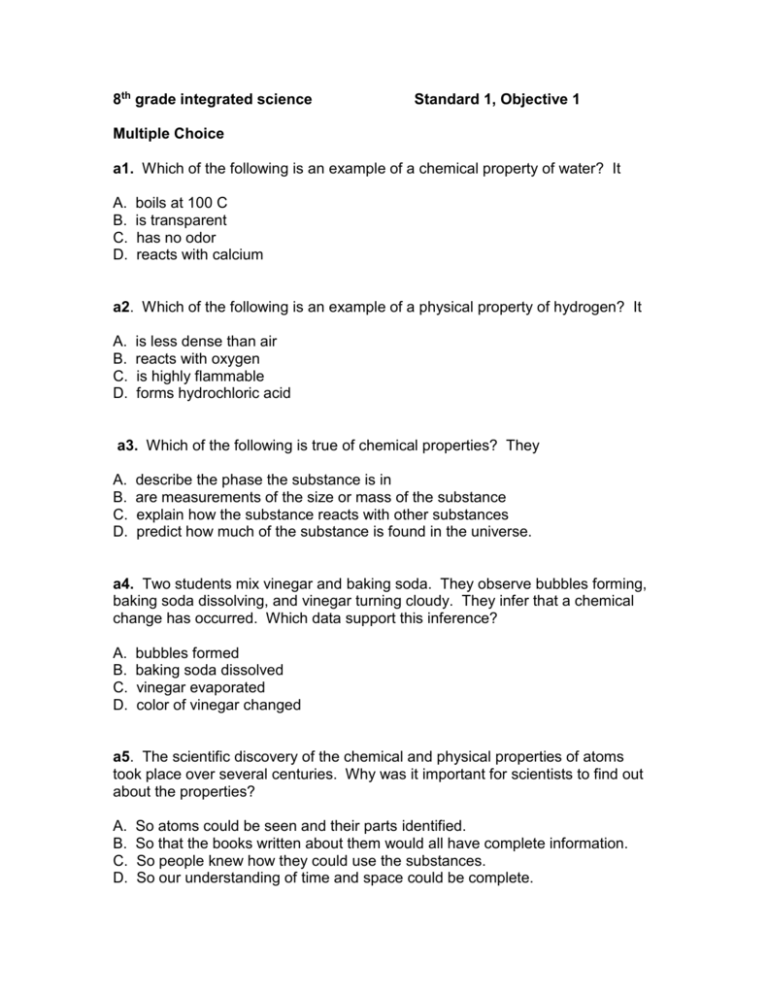
8th grade integrated science Standard 1, Objective 1 Multiple Choice a1. Which of the following is an example of a chemical property of water? It A. B. C. D. boils at 100 C is transparent has no odor reacts with calcium a2. Which of the following is an example of a physical property of hydrogen? It A. B. C. D. is less dense than air reacts with oxygen is highly flammable forms hydrochloric acid a3. Which of the following is true of chemical properties? They A. B. C. D. describe the phase the substance is in are measurements of the size or mass of the substance explain how the substance reacts with other substances predict how much of the substance is found in the universe. a4. Two students mix vinegar and baking soda. They observe bubbles forming, baking soda dissolving, and vinegar turning cloudy. They infer that a chemical change has occurred. Which data support this inference? A. B. C. D. bubbles formed baking soda dissolved vinegar evaporated color of vinegar changed a5. The scientific discovery of the chemical and physical properties of atoms took place over several centuries. Why was it important for scientists to find out about the properties? A. B. C. D. So atoms could be seen and their parts identified. So that the books written about them would all have complete information. So people knew how they could use the substances. So our understanding of time and space could be complete. Use the information in this table to answer the next two questions. Properties of 4 substances Substance Density Phase at room Reaction with temperature water Hydrogen Gas .00009 g/ml Gas None Sodium .97 g/ml Solid Carbon Argon 2.2 g/ml .002 g/ml Solid Gas Violent bubbling reaction None None Reaction to flame Burns explosively Burns explosively Burns slowly None a6. Which substance showed no chemical change? A. B. C. D. hydrogen sodium carbon argon a7. Which of the tests measured physical properties? A. B. C. D. density, reaction to flame density, phase reaction to flame and water phase, reaction to water Use this list to answer the next two questions: common substances: salt, water, air, sugar, iron, paper, plastic milk carton, gasoline b8. Which of these substances would be classified as highly flammable? A. B. C. D. salt, air iron, plastic paper, gasoline water, sugar b9. Which of these substances would be classified as flexible? A. B. C. D. salt, iron water, paper sugar, gasoline paper, plastic b10. Marie Curie was the first scientist to purify and name the element Radon. What must she have done to describe Radon to other scientists? A. B. C. D. discovered its chemical and physical characteristics tell them how much she enjoyed finding it in the ore. found pictures in a book to share with them. looked all over the world for other samples of pure Radon b11. A student finds an interesting substance and tests it several ways. The substance is a liquid, dark in color and does not react with baking soda or metals. The student looks on the Internet to see if he can find out what it is. How is the student using scientific methods? A. B. C. D. he is looking for and finding new things. he is using the Internet to look up information he is classifying a substance based on its characteristics he is doing an experiment with a controlled variable. The following information was found in a search for information on “gold”. Use it to answer the next three questions: Gold Gold is the most malleable metal. A single gram can be beaten into a sheet of one square meter. Gold leaf can be beaten thin enough to allow light to shine through it. Gold is a good conductor of heat and electricity, and is not affected by air and other chemicals. Heat, moisture, oxygen, and most corrosive agents have very little chemical effect on gold, making it useful for use in coins and jewelry. Because of its low reactivity, pure, metallic gold is tasteless. In addition, gold is very dense, a cubic centimeter weighing 19.3 g. By comparison, the density of lead is 11.3 g/cm³. c12. Which of the following is a chemical property of gold? A. B. C. D. does not react with most other chemicals. is very malleable, can form thin sheets is very dense it forms beautiful and valuable jewelry. c13. Thin sheets of gold are often used to cover clay statues to create the appearance of the statue being made of solid gold. Which property of gold allows it to be used this way? A. B. C. D. Taste Density Reactivity Malleability c14. Which properties of gold make it valuable for use in computers and satelites? A. B. C. D. it is yellow in color and has no taste. it conducts electricity and not affected by other chemicals it forms thin sheets and has a high density it can be reused to make jewelry and other valuable objects. Essay 1. Describe the difference between a chemical and a physical property. Give an example of each. 2. Pick a substance you are familiar with and describe a physical property and a chemical property of that substance.
